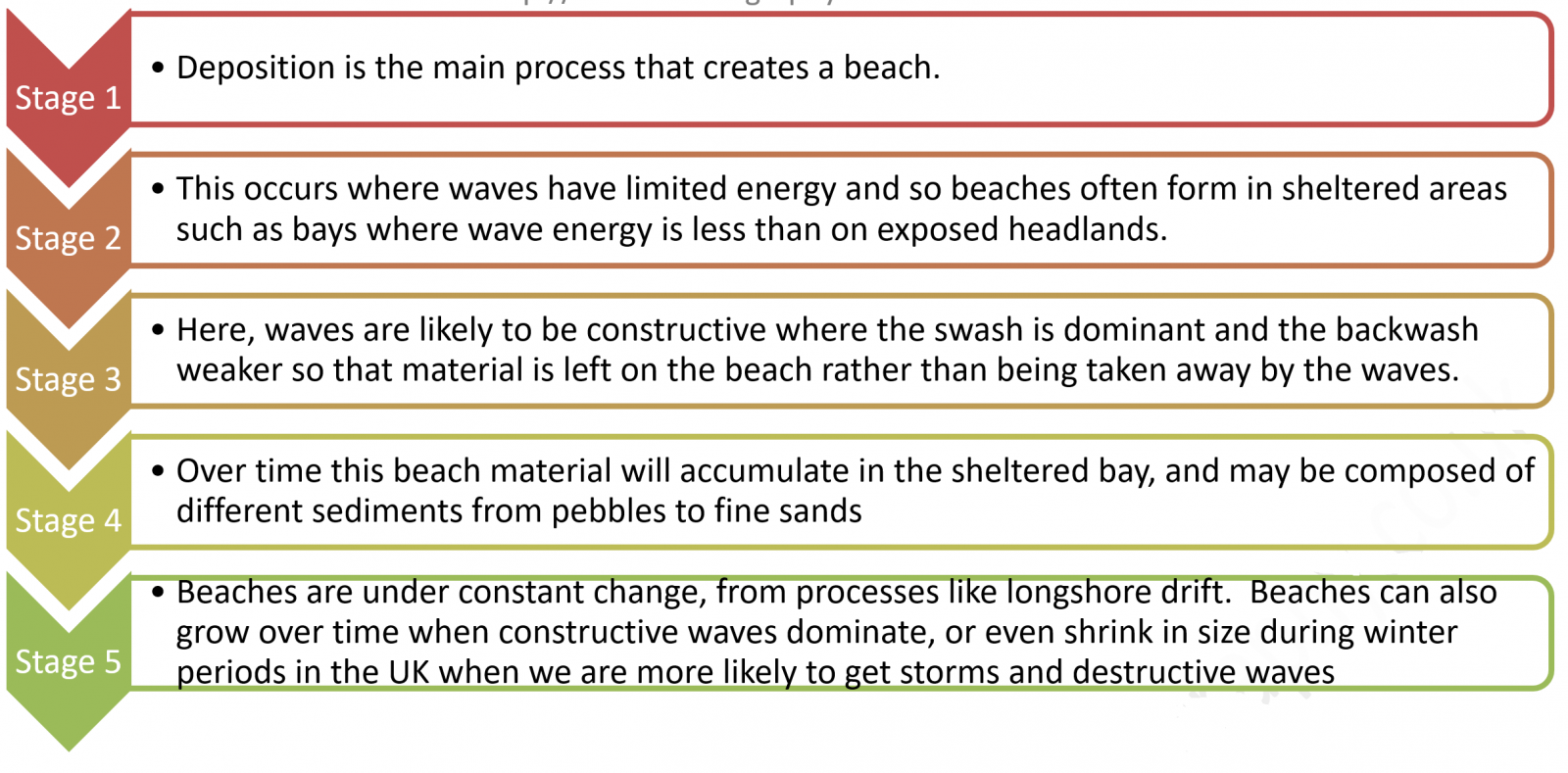Physical landscapes in the UK - GCSE
1/31
There's no tags or description
Looks like no tags are added yet.
Name | Mastery | Learn | Test | Matching | Spaced |
|---|
No study sessions yet.
32 Terms
The two types of wave, with explained processes
Constructive and Destructive waves.
Constructive waves are when the swash is bigger than backwash and material gets pushed up to the back of beaches rather than removed. Constructive waves have low wave heights, lower wave frequencies (they break less often) and the waves are less steep. These waves are created by storms far out to sea which create a large swell which eventually reaches the coast.
Where backwash is larger than swash more material is being eroded from the beach profile than is being accumulated. This carries material out to sea and makes for a steeper beach profile. These waves are called destructive waves which have steeper wave profiles, larger and higher wave crests and come more frequently. These waves are generated during large storms, such as the depressions which affect the British Isles.
The climate of the area
Temperature and rainfall can affect which weathering processes occur.
Mechanical weathering
Weathering processes that cause physical disintegration or break up of exposed rock without any change in the chemical composition of the rock, for instance freeze thaw. This is one process where water enters cracks, freezes (often overnight), expands by 9.05% and exerts pressure on the rock, weakening it.
Chemical weathering
This involve the chemical alteration of the structure of rocks, processes include carbonation (were weak carbonic acids attack rocks) and hydration (where water swells the structure of rock)
Mass movement
Once weakened by weathering mass movement can then deliver this material to beaches and the sea to be eroded. Some mass movement processes occur slowly, such as soil creep and solifluction, but some are very rapid such as rock falls and slumping which is the rapid mass movement which involves a whole segment of the cliff moving down-slope.
Coastal erosion with all 4 types
This is the wearing away of the land by moving agents such as the sea. There are several types operating at the coast including:
Hydraulic Power - this is where water from a wave enters cracks in the cliff face, compresses air within the cracks and causes pressure to be exerted on the surrounding rock, which weakens and breaks off.
Corrosion - weak acids within the sea can react with certain rocks types at the coast and cause them to dissolve slowly, this is particularly important for Limestone and chalk coastlines.
Abrasion - This is where rocks picked up and carried within waves are thrown onto the beach and cliffs
Attrition - This is where rocks and pebbles carried within the sea hit against one another and break down into smaller particles.
Coastal TRANSPORT including the 5 types
This is the movement of material along a coastline. Sediment can be moved by 4 basic processes:
Traction - where large stones are rolled along the sea bed
Saltation - where stones are bounced along the sea bed in a hopping motion
Suspension - where fine material is held within the water mass
Solution - where rocks and minerals are dissolved within the water.
Longshore drift - moves sediment in one general direction along the coastline in a zig-zag fashion, governed by the prevailing wind. This action is important, as it moves or erodes sediment from an up current area and moves it down current, changing the shape and sizes of beaches.
Coastal deposition
Deposition occurs when wave velocities slow, or when ocean currents slow due to encountering frictional forces such as the sea bed, other counter currents and vegetation. Deposition is simply the laying down of preciously eroded and weathered material. We encounter deposition in slow wave environments such as in bays, where contrasting sea currents or river currents slow water down, and why there are low winds (and hence low wave velocities).
Arch
A wave-eroded passage through a small headland. This begins as a cave formed in the headland, which is gradually widened and deepened until it cuts through.
Cave
A large hole in the cliff caused by waves forcing their way into cracks in the cliff face.
Cliff
A steep high rock face formed by weathering and erosion along the coastline.
Headlands and Bays
A rocky coastal promontory made of rock that is resistant to erosion; headlands lie between bays of less resistant rock where the land has been eroded back by the sea.
Stack
An isolated pillar of rock left when the top of an arch has collapsed; over time further erosion reduces the stack to a smaller, lower stump.
Wave cut platform
A rocky, level shelf at or around sea level representing the base of old, retreated cliffs.
Erosional example
Dorset Coast
Headlands
Durlston Head - A discordant coastline has rocks of different hardness aligned at right angles to the coast. Hard rock such as chalk will be eroded slower than soft rock such as clay. Destructive waves use hydraulic engineering (high power waves pounding the cliff face), and abrasion (hurling shingle and sand at the cliff face causing rocks to come loose and come out weakening the cliff).
Bays
Lulworth Cove - Waves have broken through a weakness in the cliff headland and begins as a cave until it is widened and deepened and the destructive wave can finally cut through.
Cliffs
The Dorset coastline has many cliffs. Marine erosion processes attack the foot of the cliff and cause the erosion at a wave cut notch through hydraulic action and abrasion. These processes erode the wave cut notch at the base of the cliff undermining the whole structure of the cliff. These processes are variable and depend upon the fetch of the wave (the distance it travels over open water), wind speed and how many storms there a year, but they are more or less continuous over long periods of time.
Wave cut platform
The bit at the bottom the cliff, basically the sloping seabed in front of it.
Caves, arches, stacks and stumps
These features are formed on cliffs or headlands. Waves attack vertical lines of weakness in the rock known as Faults. Processes such as hydraulic action and abrasion widen these faults into cracks and eventually the waves will penetrate deeply enough to create caves. Over time, the cave will be eroded into an arch, accessible to the sea on both sides. Weathering will also play a role, with physical weathering processes such as freeze thaw and salt crystallisation and chemical processes such as carbonation weakening the rock surrounding the cave or arch making it more susceptible to mass movement and collapse. Finally, the erosion and weathering continues and the arch collapses leaving behind a stack (a vertical column of rock). These stacks can be attacked further, and eventually the stack may collapse to leave a low-lying stump.
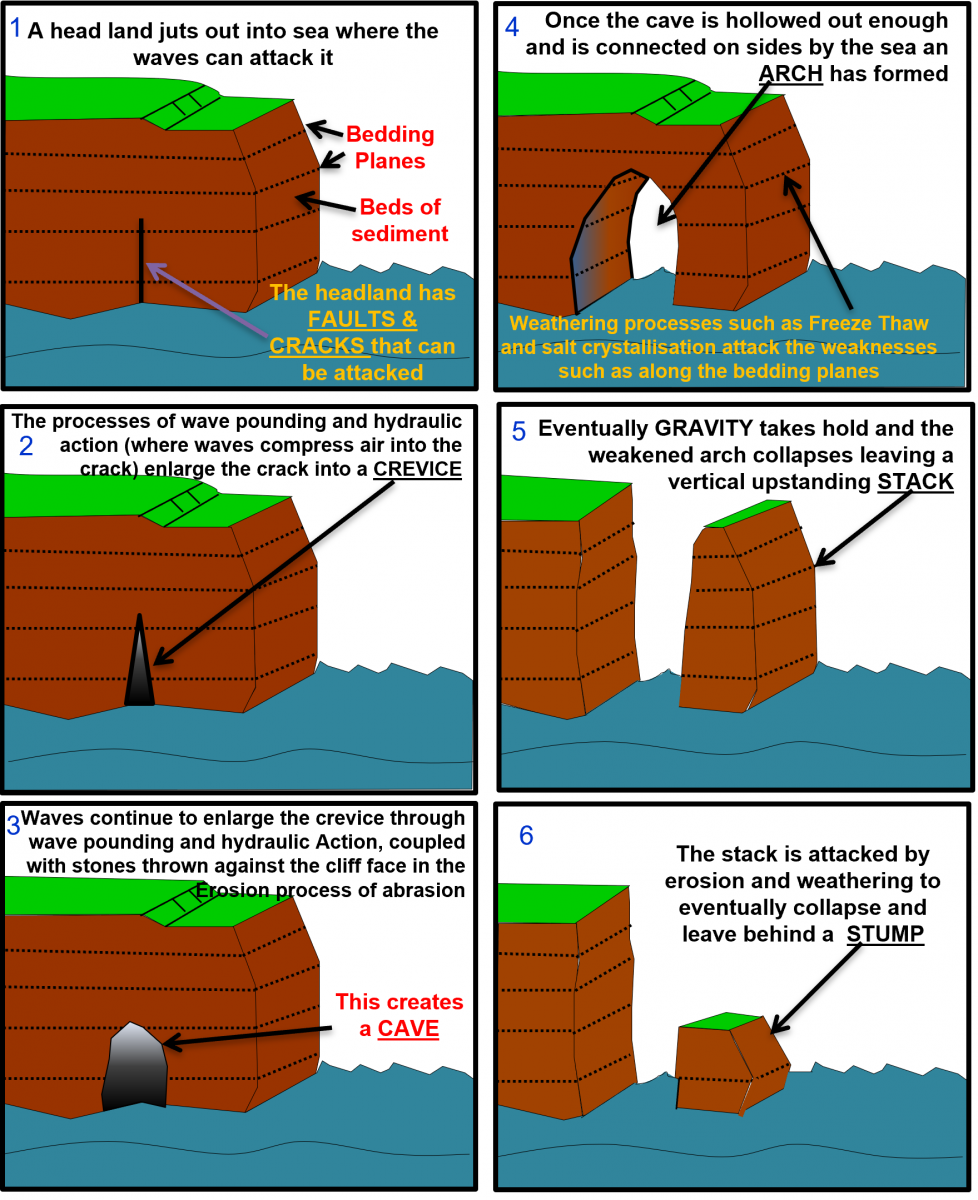
Depositional
Beaches have formed along the Holderness Coast due to the deposition of sand and shingle transported by longshore drift. The eroded material is transported from north to south along the coast.
Sand Dunes
Sand dunes are accumulations of sand and other sized sediments that gather on a beach. Sand dunes are created around obstacles on the beach, these could be natural such as a rock or human things such as some waste drift wood or a fence.
The sea brings sediment to the beach and then the wind redistributes that sediment. When the wind encounters the beach obstacles velocity falls and sediment is DEPOSITED. This makes amount of sand or sediment at the front of the sand dune system, known as an EMBRYO dune.
Over time, tough plants known as PIONEERS such as Marram grass take root on the dune, their root systems helping to stabilise the sand and fix it in place.
As these plants die off they add nutrients and humus to the sand dune improving the soil, so more complex plants can move in, such as brambles.
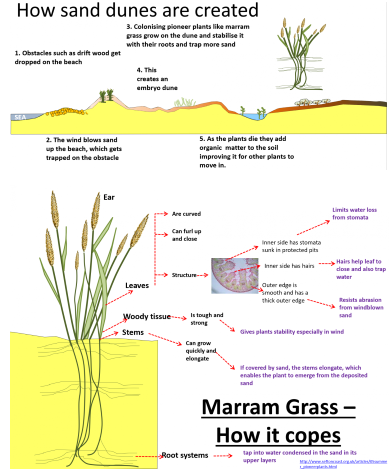
Spurn Point
Spurn Point provides evidence of longshore drift on the Holderness Coast. It is an excellent example of a spit. Spits are created by the process of Longshore drift. Some eroded material ends up caught up within the waves and is carried by the sea along the coastline in cells known as littoral cells. Material is carried along the shore in a zigzag fashion by waves as they swash material up the beach at an angle and backwash material down the beach at a right angle. The angle of swash is determined by the prevailing wind (the dominant or main direction in which the wind blows).
The formation of bays and headlands
In areas where the geology or rock type runs at right angles to the coastline, bays and headlands can be created. If there are alternating bands of harder and softer rock running at right angles to the sea, the sea will erode these bands at different rates (called differential erosion). Hydraulic action, abrasion and corrosion are more effective at eroding the softer rock, particularly during storms, and this will erode further inland than the harder rock. During calmer weather and no stormy periods, the hard rock will absorb a lot of the wave energy and refract or bend the waves into the area with the softer rock, allowing sediment to be deposited and accumulate as beaches. The net result of this over long periods of time is that the hard rock is left jutting out to sea as a headland, and the softer rock is eroded into curved sand filled bays.
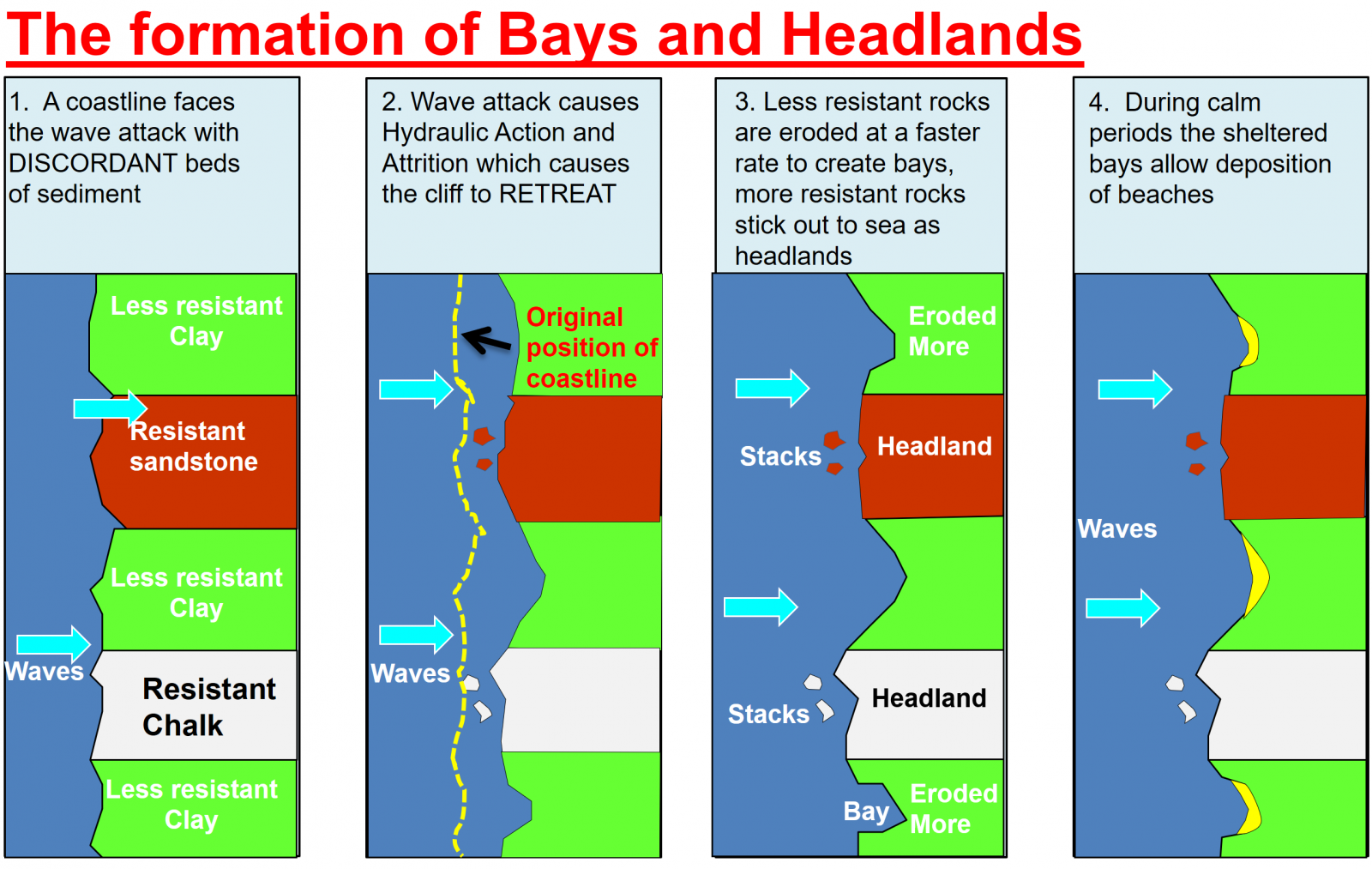
Cliffs and cliff retreat
A cliff is a vertical, near vertical or sloping wall of rock or sediment that borders the sea. They generally differ in their angle of slope because of their rock structure and geology, but the processes involved in their formation are the same.
Marine erosion processes attack the foot of the cliff and cause the erosion at a wave cut notch. Waves can pound this area causing fragments to break off, and the water can also trap air in pore spaces, faults and crevices, compressing the air which in turn exerts pressure on the rock causing it to break off. This process is known as hydraulic action. Another process that occurs is corrasion, where sediment and rocks in the sea water are hurled against the cliff face. All three of these processes erode the wave cut notch at the base of the cliff undermining the whole structure of the cliff. These processes are variable and depend upon the fetch of the wave (the distance it travels over open water), wind speed and how many storms there a year, but they are more or less continuous over long periods of time.
At the same time that the base of the cliff is being eroded, the cliff face and its structure are being weakened by weathering processes. Oxidation and carbonation are some of the chemical processes that can weaken the structure of the rock, and depending upon the climate physical processes such as freeze thaw and water layer weathering can take effect. Over time this weakens the structure of the cliff face, and coupled with the erosion of the wave cut notch at a critical point this cliff face will succumb to the influence of gravity and collapse in a process of mass movement. This material will then be carried away by the sea in the process of long shore drift by the transportation process of solution, suspension, saltation and traction (depending upon the particle sizes). The cliff retreats, leaving behind a flat wave cut platform.
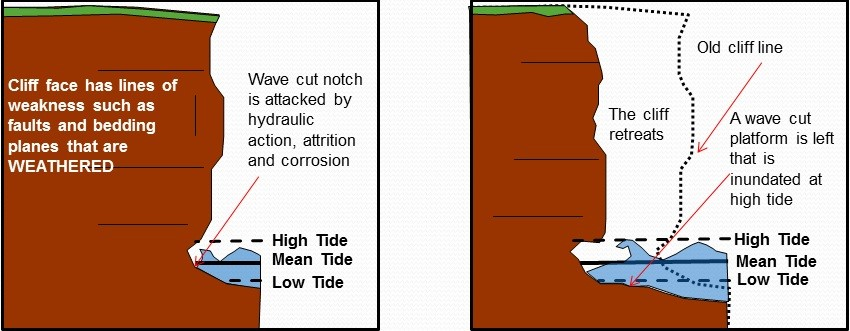
Bars
Where a spit grows across a bay, a bay bar can eventually enclose the bay to create a lagoon. Bars can also form offshore due to the action of breaking waves.
Beaches
The zone of deposited material that extends from the low water line to the limit of storm waves. The beach or shore can be divided in the foreshore and the backshore.
Deposition
Occurs when material being transported by the sea is dropped due to the sea losing energy.
Longshore drift
The zigzag movement of sediment along a shore caused by waves going up the beach at an oblique angle (Swash) and returning at right angles (backwash). This results in the gradual movement of beach materials along the coast.
Sand dunes
Coastal sand hill above the high tide mark, shaped by wind action, covered with grasses and shrubs.
Spits
Depositional landforms formed when a finger of sediment extends from the shore out to sea, often at a river mouth. They usually have a curved end because of opposing winds and currents.
Depositional process
Deposition occurs when wave velocities slow, or when ocean currents slow due to encountering frictional forces such as the sea bed, other counter currents and vegetation.
